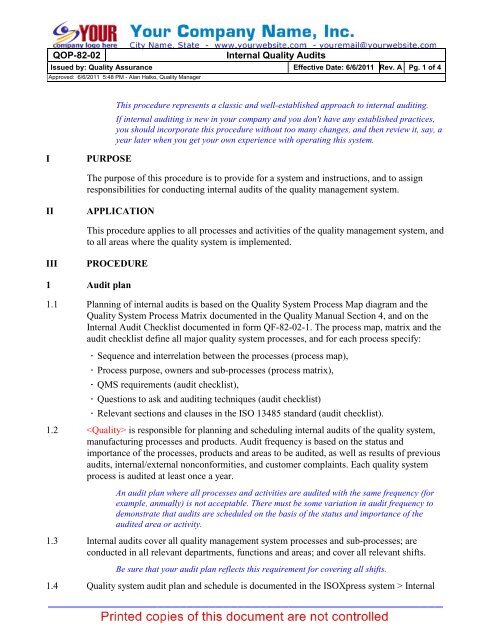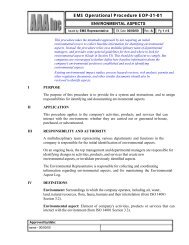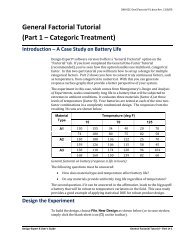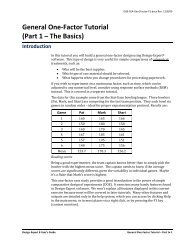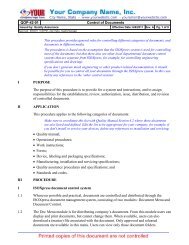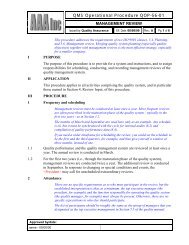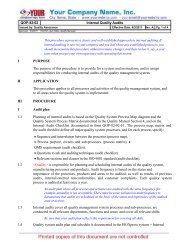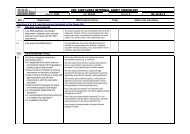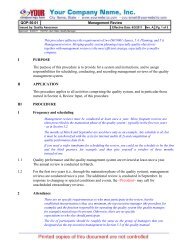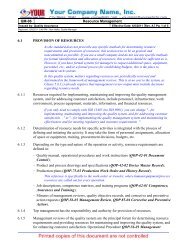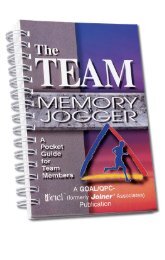Operational Procedure QOP-82-02 Internal Quality ... - Quality Coach
Operational Procedure QOP-82-02 Internal Quality ... - Quality Coach
Operational Procedure QOP-82-02 Internal Quality ... - Quality Coach
- No tags were found...
You also want an ePaper? Increase the reach of your titles
YUMPU automatically turns print PDFs into web optimized ePapers that Google loves.
<strong>QOP</strong>-<strong>82</strong>-<strong>02</strong><strong>Internal</strong> <strong>Quality</strong> AuditsIssued by: <strong>Quality</strong> Assurance Effective Date: 6/6/2011 Rev. A Pg. 1 of 4Approved: 6/6/2011 5:48 PM - Alan Halko, <strong>Quality</strong> ManagerThis procedure represents a classic and well-established approach to internal auditing.If internal auditing is new in your company and you don't have any established practices,you should incorporate this procedure without too many changes, and then review it, say, ayear later when you get your own experience with operating this system.IPURPOSEThe purpose of this procedure is to provide for a system and instructions, and to assignresponsibilities for conducting internal audits of the quality management system.IIAPPLICATIONThis procedure applies to all processes and activities of the quality management system, andto all areas where the quality system is implemented.IIIPROCEDURE1 Audit plan1.1 Planning of internal audits is based on the <strong>Quality</strong> System Process Map diagram and the<strong>Quality</strong> System Process Matrix documented in the <strong>Quality</strong> Manual Section 4, and on the<strong>Internal</strong> Audit Checklist documented in form QF-<strong>82</strong>-<strong>02</strong>-1. The process map, matrix and theaudit checklist define all major quality system processes, and for each process specify:· Sequence and interrelation between the processes (process map),· Process purpose, owners and sub-processes (process matrix),· QMS requirements (audit checklist),· Questions to ask and auditing techniques (audit checklist)· Relevant sections and clauses in the ISO 13485 standard (audit checklist).1.2 is responsible for planning and scheduling internal audits of the quality system,manufacturing processes and products. Audit frequency is based on the status andimportance of the processes, products and areas to be audited, as well as results of previousaudits, internal/external nonconformities, and customer complaints. Each quality systemprocess is audited at least once a year.An audit plan where all processes and activities are audited with the same frequency (forexample, annually) is not acceptable. There must be some variation in audit frequency todemonstrate that audits are scheduled on the basis of the status and importance of theaudited area or activity.1.3 <strong>Internal</strong> audits cover all quality management system processes and sub-processes; areconducted in all relevant departments, functions and areas; and cover all relevant shifts.Be sure that your audit plan reflects this requirement for covering all shifts.1.4 <strong>Quality</strong> system audit plan and schedule is documented in the ISOXpress system > <strong>Internal</strong>
<strong>QOP</strong>-<strong>82</strong>-<strong>02</strong> <strong>Internal</strong> <strong>Quality</strong> Audits Rev. A Pg. 2 of 4Audits module (select the audit in the grid, and click the Audit Plan button in the top menu).The audit plan lists processes of the quality system to be audited and the planned audit datesand assigned auditors. More detailed scope and reference for the audit, to include relevantsub-processes, procedures, areas/functions and reference clauses of ISO 9001 standard, areprovided in the <strong>Quality</strong> System Process Map diagram (QM 4.1.1), the <strong>Quality</strong> SystemProcess Matrix (QM 4.1.1), and the <strong>Internal</strong> Audit Checklist (form QF-<strong>82</strong>-<strong>02</strong>-1).Note that the Audit Plan in the ISOXpress system is actually just the schedule component ofthe internal audit plan. The actual scope and reference for the internal auditing programare defined in the <strong>Quality</strong> System Process Map diagram, the <strong>Quality</strong> System Process Matrix,and the <strong>Internal</strong> Audit Checklist.1.5 <strong>Internal</strong> audit plans and cycles are synchronized with management reviews of the qualitysystem (refer to <strong>Operational</strong> <strong>Procedure</strong> <strong>QOP</strong>-56-01, Management Review), so that completeresults from the full auditing cycle are available in time for the management review meeting.2 Audit team2.1 is responsible for qualifying, training and assigning internal auditors. Personnelassigned to carry out internal audits are independent of those having direct responsibility forthe audited activity.Edit this as appropriate to your company, but be sure to clearly communicate therequirement for objectivity and impartiality of the auditor.2.2 <strong>Internal</strong> auditors are qualified on the basis of their education, experience and training.Minimum requirements are:· Education: High School graduation· Experience: Two years in the industry· Training: 16 hours external or in-house trainingThe training can be by an external course or seminar provided by a qualified institution (suchas a registrar, accredited training organization, etc.), or in-house training provided by aqualified consultant/trainer. If training is provided in-house, the trainer must havedocumented qualifications as a Lead Auditor.3 Preparing for auditThe standard explicitly requires that internal auditors must be qualified, but does not stateany particular qualification criteria. The criteria defined in this clause are just an example.3.1 Auditors prepare for an audit by:· Reviewing the <strong>Quality</strong> System Process Map diagram, the <strong>Quality</strong> System Process Matrix(documented in the <strong>Quality</strong> Manual Section 4), and the <strong>Internal</strong> Audit Checklist (documentedin QF-<strong>82</strong>-<strong>02</strong>-1);· Refreshing their knowledge of the quality manual and relevant operational procedures;· Reviewing nonconformity reports, customer complaints, and corrective action files; and· Customizing and augmenting (as necessary) the <strong>Internal</strong> Audit Checklist.
<strong>QOP</strong>-<strong>82</strong>-<strong>02</strong> <strong>Internal</strong> <strong>Quality</strong> Audits Rev. A Pg. 3 of 44 Conducting and reporting the audit4.1 The manager responsible for the area scheduled for audit is contacted at least one week inadvance with the proposed audit date. The manager responds with a confirmation, orproposes an alternative date.4.2 In conducting the audit, auditors generally follow the <strong>Internal</strong> Audit Checklist (QF-<strong>82</strong>-<strong>02</strong>-1).The checklist defines the minim scope criteria (requirements) for the audit and providesexamples of relevant questions and auditing techniques. The checklist is also used forreferencing reviewed evidence and keeping audit notes.4.3 When a nonconformity is noted, it is brought to the attention of, and discussed with, theresponsible manager. Before the end of the audit each noted nonconformity is documented inthe ISOXpress system > <strong>Internal</strong> Audits > Audit Findings. Auditors fill out only the topblock (references and particulars) and the Finding block of the audit finding form, describingthe noted nonconformity. The form is then processed by the responsible manager who usesits second and third block to determine root causes and document the corrective action.5 Corrective action and follow upIn this procedure, the process for requesting and implementing corrective actions resultingfrom audit findings is incorporated into the Audit Finding form in the ISOXpress system.Thus, the general Corrective and Preventive Action procedure and form do not apply toaudits. While, in theory, the general Corrective and Preventive Action system could be usedfor internal audit findings, it is not a good idea. Audit findings must always be addressed asa priority, and within a specified time frame; because an open finding means that the qualitysystem is technically in default.5.1 Once a nonconformity is identified and documented, further processing of the audit findingform is similar to the corrective action requests (<strong>Operational</strong> <strong>Procedure</strong> <strong>QOP</strong>-85-03,Corrective and Preventive Action). The responsible manager investigates the root causes ofthe problem noted as a nonconformity, and implements and documents appropriatecorrective action.5.2 On, or immediately after the due date for implementation of corrective action, the auditorfollows up with an inquiry or an audit to determine if the corrective action has beenimplemented and if it is effective. When there is objective evidence that the corrective actionis effective, the audit finding is closed out. If more work is needed to fully implement theaction, the due date may be extended by up to 30 days.6 Managing, closing out, and reviewing the audit6.1 Progress and status of the <strong>Internal</strong> Audit process is managed and monitored in the ISOXpresssystem > <strong>Internal</strong> Audits module (select the audit in the grid, and click the Audit Plan buttonin the top menu). For each completed item, the ‘Actual Date’ and ‘Status’ are recorded in theplan.6.2 The internal audit is closed when the whole audit plan is completed and all audit findings areclosed out. The status of the audit is recorded in the ISOXpress system > <strong>Internal</strong> Audits
<strong>QOP</strong>-<strong>82</strong>-<strong>02</strong> <strong>Internal</strong> <strong>Quality</strong> Audits Rev. A Pg. 4 of 4form.6.3 At the end of an auditing cycle, all nonconformity reports established during the cycle arecompiled and analyzed, and are presented at the management review meeting (refer to<strong>Operational</strong> <strong>Procedure</strong> <strong>QOP</strong>-56-01, Management Review).IVASSOCIATED DOCUMENTS· QM Section 4.1.1, <strong>Quality</strong> System Process Map diagram· QM Section 4.1.1, <strong>Quality</strong> System Process Matrix· Form QF-<strong>82</strong>-<strong>02</strong>-1, <strong>Internal</strong> Audit Checklist· <strong>Operational</strong> <strong>Procedure</strong> <strong>QOP</strong>-42-<strong>02</strong>, Control of Records· <strong>Operational</strong> <strong>Procedure</strong> <strong>QOP</strong>-56-01, Management Review· <strong>Operational</strong> <strong>Procedure</strong> <strong>QOP</strong>-85-03, Corrective and Preventive ActionVASSOCIATED RECORDS· <strong>Internal</strong> audit plans: Plans for quality management system audits. Maintained in theISOXpress system > <strong>Internal</strong> Audits module.· <strong>Internal</strong> Audit Checklists: Checklist filled out with comments and references noted byauditors during the audit. Established using form QF-<strong>82</strong>-<strong>02</strong>-3, <strong>Internal</strong> Audit Checklist.· Audit Finding Reports: Reports with audit findings and records of correspondingcorrective actions. Established and maintained in the ISOXpress system > <strong>Internal</strong> Audits >Audit findings module.FOR MORE INFORMATION AND BUYING OPTIONSPlease follow the link below to learn more and purchase the template documentationISO 13485 FDA QSR (21 CFR <strong>82</strong>0) <strong>Quality</strong> Manual Templateshttp://www.qualitycoach.net/shop/shopexd.asp?id=5860


